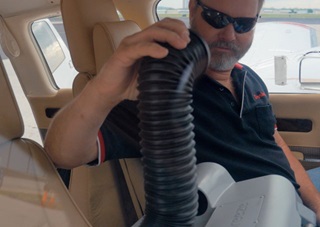
The summer sun beats down on the ramp, the heat visible in shimmering waves; the air inside the cockpit will surely be stagnant and hot, hot, hot—40 degrees or more above the ambient temperature in the shade. It’s uncomfortable, and it can also impair a pilot’s performance, as noted in a 1998 issue of Flight Training. Increased body temperature is associated with decreased mental acuity, so keeping cool is about more than just comfort. Wearing light clothing and drinking plenty of water are a good start, but air conditioning remains the gold standard of cockpit cool.
Gold is the operative word. Factory-installed systems typically add tens of thousands to an aircraft’s price. Retrofits are available for many common general aviation aircraft under supplemental type certificate installations that typically include an auxiliary alternator to feed the power-hungry systems.
There are much cheaper alternatives.
Those with a little can-do spirit, basic tools, and about $30 to spend can find step-by-step instructions for creating a simple but reportedly effective air conditioner using a cooler (ice chest), a fan, and a little ducting. Another how-to video covering the same strategy was posted on YouTube in 2014.
If cutting holes in a cooler, mounting a fan (which can be battery powered, solar powered, or run off of a 12-volt outlet available in most aircraft), and attaching duct work is not your thing, there are at least three manufacturers producing prefabricated setups for prices starting at $300. B-Kool offers such a setup online, with an optional wireless remote control (the cooler will most likely find a home in the baggage area). Arctic Air sells a wider range of options, up to a 52-quart cooler fitted with two fans for $610 ($630 for a 24-volt version, or the 12-volt model with a louvered vent). IcyBreeze sells a range of models from $349 to $425, and those coolers come with wheels. The company notes in its marketing materials that your beverages also can be stored in the cooler, just like a regular ice chest.
“We are able to provide all the benefits of a cooler plus true air conditioning, in a compact and portable unit that has no Freon or chemicals and gives off no harmful exhaust,” said IcyBreeze CEO and President Andrew Jenkins, in a recent news release.
Stocked with ice and a little water, the IcyBreeze weighs 46 pounds; competing models are similar in size and weight, and not much heavier than the total weight of typical installed air conditioning systems. Blowing air over ice can drop the temperature of that air by 30 degrees or more (IcyBreeze claims a 35-degree temperature delta), and the ice can last several hours. (Block ice lasts longer than cubes, though it may not do as good a job chilling beverages.) Actual cabin temperatures will vary depending on conditions, the size of the windows, and other factors, though all of these systems will take the edge off—particularly during ground operations where open windows and vents offer limited relief.
The auto racing world offers yet another option in the same price range as the prefabricated ice chests with fans: shirts with built-in tubing to circulate fluid chilled in a separate cooling unit. Such systems sell online for around $400, and while they only cool one person at a time, the total system weighs only three or four pounds (they’re designed primarily for race cars, which also place a premium on reducing weight).
Ice packs in your pockets are cheaper, of course, but probably less effective. Search “personal cooling system” online and you’ll find a range of wearable systems (vests, neck-mounted fans, and misters among them) that can take the edge off—for a lot less than the cost of a typical aircraft air conditioner. If that doesn’t cut it, Arctic Air offers three portable air conditioners in the $4,600 to $4,750 price range, which provide up to 400 cubic feet per minute of circulation, and can be removed in the cool season. They still require a mechanic’s touch to install, since the exhaust air needs to be vented outside the aircraft, and the electrical system may need an upgrade.
Have you tried one or more of these products or strategies? Share your experience with fellow pilots in the comment area below, and let’s all chill out together.



